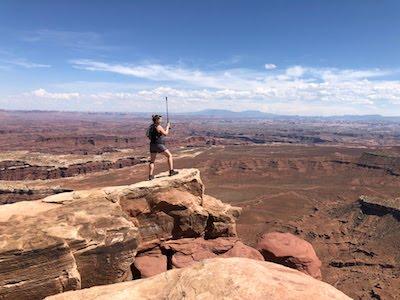
Submitted by Angela Walters on Wed, 28/11/2018 - 10:12
A collaborative project between Stanford University, in the US, and the University of Cambridge is combining Virtual Reality technology and education to bring the outside world to children who are not able to experience it. Kathy Ho, a teacher at the Packard Children’s Hospital at Stanford, Gemma Gordon, a Research Associate at the Cambridge Department of Computer Science and Technology, and Anil Madhavapeddy, Lecturer at the Cambridge Department of Computer Science and Technology are looking to the future through Imagine.
Imagine watching the sun set over the unfathomable vastness that is the Grand Canyon National Park. North America’s greatest natural wonder stretches out in front of you, all precipitous drops and folds of rock that were millions of years in the making. Imagine being teleported to this wondrous place from a hospital bed or a schoolroom; suddenly the four walls around you open up to a vista that is hundreds or thousands of miles away from where you actually are. But you are there; feeling it, hearing it, entirely immersed.
Connecting to the wider world though VR is the focus of the LABScI Imagine project, a collaboration between the Stanford University LABScI programme and the University of Cambridge Department of Computer Science and Technology, which aims to use cutting-edge technology to facilitate learning in non-standard classroom environments.
LABScI is a hospital school science programme sponsored by the Spakowitz Research Group at Stanford University and based at the Packard Children’s Hospital at Stanford. LABScI creates hands-on lessons (referred to as labs) for students in non-traditional educational settings such as hospital school classrooms, hospital bedsides, home schools, or other resource-limited settings. The educators and volunteers delivering this programme have to consider unique factors and challenges including restrictions on patient mobility, medical isolation, lack of teaching resources or specialised instructors and hospital restrictions on sharps, chemicals and open flames. The Systems Research Group within the Department of Computer Science and Technology seeks to broaden the use of modern technology within climate and environmental education and encourage open source development of accessible solutions.
Imagine received a grant from National Geographic Society in 2016 to fund the field expedition, and also received funding for the technology development as a CDBB Mini Project; titled ‘Feasibility of an Operating System for Interspatial Networking in a Built Environment’. The technology centred around a new operating system ‘Osmose’ which builds on decades worth of work on networking and systems infrastructure from the Department of Computer Science and Technology. Osmose is unlike other software in this space and is designed to work with a wide array of independently designed and deployed devices to deliver a shared immersive experience where the technology is invisible, becoming an integral part of the building. The team is working with Pembroke College, which is undergoing its first expansion in 220 years and plans to integrate this prototype technology into the new building, which will provide a focal point for longer-term research.
More immediate plans focus on creating a Virtual Reality Field Trip Programme for students unable to experience nature firsthand. In the summer of 2018, the team visited 32 different National Parks in the United States spanning Arizona, Utah, Nevada, California and Colorado to gather footage from the American West which will be used to develop interdisciplinary curricula with a STEM focus. The team is currently working through terabytes of footage and designing the curriculum and delivery platform.
The curated lessons will be demonstrated on inexpensive, readily available technology such as Google Cardboard VR together with hands-on lab activities. Lessons will include topics such as deposition and erosion; plate tectonics and geological uplift; desert adaptations; local flora and fauna; human geography; and anthropological history in the area. The team interviewed park rangers about the possibility of providing field specialists with low-cost, energy efficient, low-latency recording and sensing equipment to wear and use in their daily jobs, which could provide ongoing footage for the Imagine lessons.
Connecting children to nature in this way can encourage them to begin to care about the environment – by showing children how individual actions and decisions can make a difference to their local environment and the world beyond.
Feedback to date has been very positive; one of the rangers at Capitol Reef National Park viewed the team’s 360 VR footage from Spooky Gulch and was ecstatic because severe claustrophobia has prevented her from hiking down the slot canyon. The LABScl team has delivered two lessons to students and teachers have reported a heightened interest in the subject matter when it is delivered via VR method.
If funding allows, longer-term plans include creating more lesson-based topics, such as marine conservation – including plastics, overfishing, oil spills and coral reefs – and Arctic climate study, as well as once-in-a-lifetime experiences. The long-term goal is to extend the Imagine project to cater for and be available to anyone and everyone.
• See the Imagine project website https://labsci.github.io/imagine/ for more details and VR footage to view.
Contact: Gemma Gordon and Anil Madhavapepeddy
